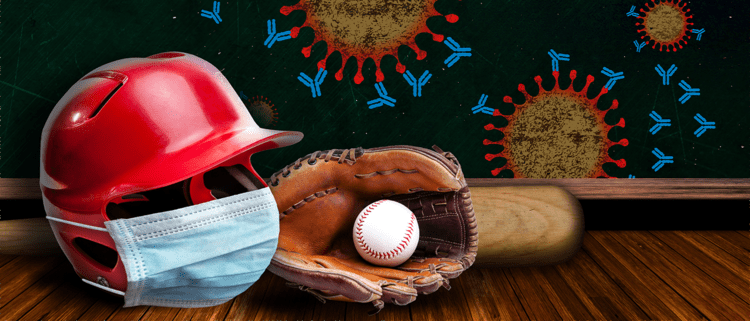The Stanford team that has been arguing since March that the American populace is closer to herd immunity than you might think has done a new survey of coronavirus antibodies in the blood to measure percentage ever infected. This time, however, to their surprise and disappointment, they came up with a quite small number when they measured 5,603 people linked to Major League Baseball, an enterprise/industry that is widely distributed around North America, with stadiums typically downtown but with players and staff generally living in the suburbs. Of the 30 major league franchises, 26 participated. From the L.A. Times:
Fewer than 1% of MLB employees test positive for COVID-19 antibodies
By BILL SHAIKIN STAFF WRITER
MAY 10, 20203:26 PMThe coronavirus outbreak largely has spared the baseball world, with data released Sunday to prove it.
Of the 5,603 major league employees who submitted to what researchers called the largest national antibody study to date, only 60 tested positive, researchers said Sunday.
There are 30 major league teams with, say, 40 players on the 40-man roster (that includes some players who go back and forth as needed between the majors and the minors). So that’s only 1200 big league ballplayers at most. So most of the testees were not big league players but were white collar office workers, coaches, grounds crews, etc. etc.
This baseball study was voluntary but suggested by franchise managements to their employees and there was a fairly high compliance rate with an average of over 200 employees being tested among 26 of the 30 franchises.
Employees of Major League Baseball are not randomly representative of the US population, of course. But on the other hand, you can picture who they are in your head and probably not be too far off. Baseball and movie theaters are useful toy industries for analysis because there is a lot of data readily available about them.
The researchers announced an estimated positive rate of 0.72% after adjusting the results for what they said were false positives and false negatives.
Angels employees had the highest positive rate among the 26 teams that participated, but the relatively small number of tests administered to each team — 123 to the Angels — made it difficult to draw conclusions, said lead researcher Jay Bhattacharya, professor of medicine at Stanford. He did say the rate of positive tests among Angels employees was lower than the infection rate in the local community.
Still, the minute percentage of positive tests provided a data point as scientists determine how wide the coronavirus has spread within the United States. Bhattacharya said he expected a larger positive rate.
“The epidemic has not gotten very far,” he said. “We have quite a way to go.”
However, in other antibody studies limited to specific locales, the positive rates have ranged from 2.8% in Santa Clara County to 24.7% in New York City. The researchers in the Major League Baseball study noted their participants were not representative of the population as a whole: 95% under the age of 65, 80% white, 60% male and 100% employed.
So 0.72% is a long way from Herd Immunity.
From the New York Times:
While the percentage of Los Angeles Angels employees with positive test was the highest among teams, the error margin is too high to draw results because just 123 tests were included from the team. …
Sixty people tested positive in the raw data, and the figured was adjusted to about 42 to account for false positives and false negatives.
So they originally came up with 60 positive tests out of about 5603 (1.1%), but after accounting for estimated false positives and false negatives, they figured their best guess for the real ratio was 42/5603 or 0.7%.
Over 95% of the participants were under 65 and few reported comorbidities, according to Stanford medical student Bianca Mulaney, who authored the study. …
Presumably, baseball players and baseball employees tend to be above average in general competence (seeing as how they tend to possess desirable jobs that even George Costanza would go to work for) and in health consciousness. On the other hand, I would imagine they are fairly popular, gregarious, and well-traveled, all traits that correlated with the early spread of CV back when it was Tom Hanks Disease.
Big league ballplayers, however, are usually forbidden in their contracts from going skiing (but not golfing). They tend to spend a fair amount of time outdoors in the winter playing golf and working out. Then the players were called to Florida and Arizona in February to begin Spring Training. I imagine big league ballplayers take public mass transit about once per decade (although as Colin Quinn admitted, John Rocker had been on the 7 Train).
Mulaney said the prevalence of positive tests for antibodies was higher in areas that have been harder hit by the virus, such as New York, and lower in less-impacted areas, such as Ohio.
I don’t see the paper available anywhere on the Internet. I can’t find the date of the testing, although I would guess the second half of April. And remember it can take a couple of weeks for antibodies to emerge, so the effective date of testing might be the first half of April.
Baseball spring training was shut down on March 13.
All in all, this is a pretty interesting Admission Against Interest, because this team of Bhattacharya, Bendavid, Ioannidis, etc. had been vocal since March that the infection was more widespread than admitted, and thus less dangerous.
On the other hand, I cannot recall reading about anybody affiliated currently affiliated with an MLB club dying of the novel disease. In fact, I’m not sure if any non-fringe MLB player has even been said to be infected yet.













